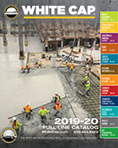4 Tips To Prevent Eyeglass Fogging
Why Glasses Fog And How To Prevent It
Contractors tasked with protecting workers from various strains of the COVID-19 virus have greater awareness for engineered controls that enable increased personal hygiene. One engineered control should focus on how to help workers reduce contact with their face and eyes. The CDC says workers can become infected from touching their eyes with contaminated fingers.
For many industries, reducing this eye and face exposure is relatively easy. But for contractors who require the use of personal protection equipment including safety glasses, goggles, and face shields, in tough conditions, there is a major problem – fogging on eyeglasses.
An Anti-Fog (AF) System Can Help Reduce Virus Spread
For years, safety directors have approached fogging as a worker’s obstacle to wearing safety glasses. A quick wipe of moisture from the lens surface could be safely accomplished when there was no risk of contact from fluids or solid particles.
But with the potential of virus spread, reducing the frequency of self-contact of PPE near a worker’s eyes is now a health priority. And this becomes even more difficult now that OSHA has recommended contractors include an administrative control requiring workers to wear face coverings on projects, increasing the potential for fogging eyewear.
Contractors can help workers experience less eyeglass fogging by providing proper eye related PPE, body cooling products, form fitting face masks, and anti-fog (AF) lens treatments.
Why Fogging Occurs
Construction workers experience fogging of safety eye protection for three main reasons.
Humidity
Construction occurs in uncontrolled environments that can be subject to high humidity. The more moisture in the air, as on hot and humid days, the more likely lenses and shields will fog.
Breathing
Face covering styles come in many styles and fabrics. While all aid in reducing virus spread, some allow warm, moist breath to move upward enveloping eye protection surfaces.
Heat And Sweat
The more common reason for fogging is the trapping of air between the interior surface of the lens or shield and the wearer’s hot face. When working hard, the body heats up, produces sweat, contributing to lens fogging.
4 Ways To Prevent Fogging
1. Select safety glasses, goggles and face shields that are designed to reduce fogging.
When choosing eyeglass frames, select style and fit that allows for more air circulation by not sitting too close to your face but still protecting your eye from danger. Some safety goggles are designed with vents to allow airflow, but be sure to check if they can be used for each task. And face shields should extend down below the workers chin to help direct flow.
To learn more about how to choose safety glasses go to https://news.whitecap.com/eye-protection/
2. Cool your face and head.
There are several accessories that reduce moisture and help cools a worker’s face area. Hardhat headband made from absorbent products soak up any sweat. There are a wide range of cooling products that wick away moisture from a workers, neck and head area. https://www.whitecap.com/ergodyne-chillits-blue-high-performance-dew-rag-64327#12481-34312481/
3. Use form-fitted face coverings.
When properly worn, these coverings create a barrier on your face covering between your mouth and nose from the safety glasses. Form fitting masks are designed to be positioned high on noses and securely tightened for a snug closing the gap around the bridge of the nose. They often have a metal clip that helps close the gap around the nose. If they don’t, try to position the safety glass frame on the mask to create a seal.
How to Wear a Face Mask Without Fogging Your Glasses
It may be one of the more innocuous problems of the coronavirus pandemic, but it’s a nuisance nonetheless: fogged-up eyewear. It happens when warm breath escapes from the top of your mask and lands on the cooler surface of your lens. As annoying as it may be, don’t stop wearing your mask.
4. Use An Effective Anti-Fog System
While the first 3 suggestions can help reduce the fogging, the most effective path for clear vision is to use products that employ Anti-Fog (AF) protection on all surfaces. AF formulations now include chemical technologies that go beyond just coating the surface with a soapy film.
For example, H2MAX, created by Pyramex, applies a durable, anti-fog treatment for that remains on lens surfaces even after repeated cleanings, a huge plus for construction workers. The anti-fog treatment extends the life of a safety eyeglass. The coating resists surface abrasion from both jobsite hazards or normal wear and tear.
Anti-fog treatments add to jobsite safety by provide workers maximum clarity in the most extreme temperature and humid conditions. H2MAX meets the appropriate ANSI and Canadian product safety standards.




Thank you for sending informative information on a regular basis.
I’m glad you find our articles useful. I take great pleasure in sharing relevant content.
I am 52 years old and supposedly I caught covid-19 guy at work. Funny thing is I never had any symptoms no fever no coughing no nothing but yet when I went and got tested they said I was positive I still don’t think I am or was or ever will be. To say the least covid is a bunch of crap if I did have it it’s the most harmless virus you ever seen.
Some people are asymptomatic. Others get mild to moderate symptoms. Some people die. Everyone is different. Glad you didn’t have a problem with it.
Thanks For sharing this amazing Information.